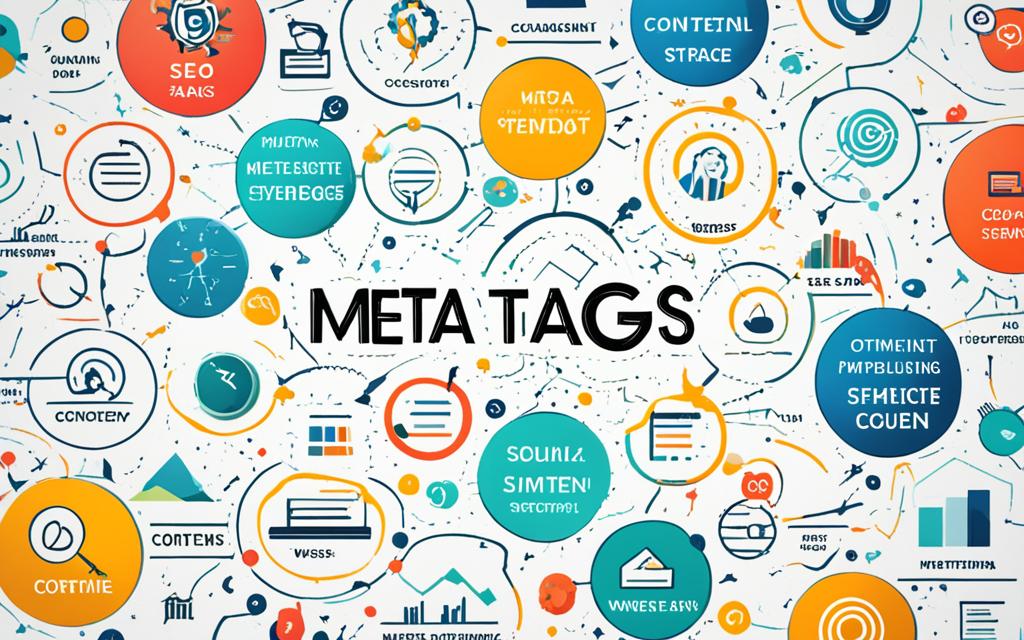Table of Contents
Meta tags are a critical element of SEO strategy. They have a significant impact on website rankings, organic traffic, and engagement rates. By optimizing meta tags, websites can improve their visibility on search engine results pages (SERPs) and attract more qualified visitors.
Meta tags play a crucial role in influencing how a webpage appears in SERPs. They provide concise information about the content of a webpage, helping search engines understand and categorize the page. This understanding allows search engines to determine the relevance and quality of the webpage, affecting its ranking on SERPs.
Furthermore, meta tags also have an impact on click-through rates (CTR) and engagement rates. A well-crafted meta title and meta description can entice users to click on a particular search result, increasing CTR. This not only drives more traffic to the website but also indicates to search engines that the webpage is valuable and relevant.
It is important to note that meta tags can impact not only traditional search results but also non-traditional ones. Platforms like Google’s Knowledge Graph, image search, and voice search rely on meta tags to provide accurate and relevant information to users. By optimizing meta tags, websites can increase their visibility in these alternative search results as well.
To maximize the SEO benefits of meta tags, it is essential to carefully craft them using relevant keywords and accurate descriptions. Each meta tag, such as the meta title, meta description, and others, should be unique and specific to its respective webpage. By doing so, websites can improve their rankings, attract more organic traffic, and enhance user engagement rates.
What are HTML Meta Tags?
HTML meta tags are essential elements that provide valuable information to both search engines and website visitors about the content of a web page. These tags serve various purposes in optimizing webpages for search engine optimization (SEO) and enhancing user experience.
Here are some important types of HTML meta tags:
- Title tags – These tags specify the title of a webpage and appear as the headline in search engine results pages (SERPs). They are crucial for attracting users’ attention and improving click-through rates.
- Meta description tags – These tags provide a brief summary of the content on a webpage. Although they do not directly affect rankings, they play a significant role in influencing users’ decision to click through to a website.
- Viewport tags – These tags optimize the display of webpages on different devices and screen sizes, ensuring a responsive design and user-friendly experience for mobile users.
- Robots tags – These tags instruct search engine crawlers on how to interact with a webpage. They can specify whether a page should be indexed or not, whether it should be followed or not, and more.
- Hreflang tags – These tags help in optimizing webpages for international audiences by indicating the language and country targeting of a particular page.
- Canonical tags – These tags play a crucial role in addressing duplicate content issues by specifying the primary version of a webpage that should be indexed by search engines.
- Open graph tags – These tags are used to optimize webpages for social media sharing. They specify title, description, and image information that social media platforms use when a webpage is shared.
When used strategically and effectively, HTML meta tags help search engines understand the content of webpages, improve search engine visibility, and enhance user engagement rates.
Impact of HTML Meta Tags
“HTML meta tags provide crucial information about a webpage to search engines and visitors. By using meta tags strategically, website owners can optimize their webpages for improved search engine rankings, increased organic traffic, and better user engagement rates.”
How do I Use Meta Tags?
Meta tags are an essential tool for optimizing the appearance and behavior of web pages. By strategically using meta tags, website owners can enhance their SEO efforts and improve their visibility in search engine results pages (SERPs). Let’s explore some of the key meta tags and their functions:
Title Tags:
Title tags play a crucial role in how a website appears in SERPs. They provide a concise and descriptive title for each webpage. By creating unique and compelling title tags that include relevant keywords, website owners can improve their click-through rates and attract more organic traffic.
Meta Description:
Meta descriptions provide a brief summary of the webpage’s content in SERPs. They give users a glimpse into what they can expect from the page and serve as a persuasive tool to encourage clicks. Crafting engaging and informative meta descriptions can significantly impact the click-through rates of webpages.
Content Type:
Content type meta tags specify the character encoding of the HTML document. This ensures that web browsers display the content correctly and helps improve the overall user experience. It is crucial to set the appropriate content type for each webpage to ensure seamless rendering across different devices and browsers.
Viewport Tags:
Viewport tags play a vital role in creating responsive and mobile-friendly web designs. By specifying the viewport’s width and initial scale, website owners can optimize the display of their webpages on various screen sizes. This ensures that the content is accessible and easy to navigate, improving user satisfaction and engagement.
Robots Tags:
Robots tags help website owners control how search engines crawl and index their content. By using robots tags, webmasters can instruct search engine bots on how to handle specific pages or sections of their website. This allows for better control over the visibility and accessibility of content.
Hreflang Tags:
Hreflang tags are essential for websites with international audiences. These tags specify the language and regional targeting of webpages, helping search engines deliver the most relevant content to users based on their location and language preferences. Hreflang tags ensure that the right pages appear in the right search results, improving user experience and engagement.
When using meta tags, it is important to align their usage with the goals and requirements of the website. By understanding the purpose of each tag and implementing them effectively, website owners can optimize their webpages for search engines, improve visibility, and drive targeted organic traffic.
| Meta Tag | Function |
|---|---|
| Title Tags | Provide a concise and descriptive title for each webpage |
| Meta Description | Offer a brief summary of the webpage’s content |
| Content Type | Specify the character encoding of the HTML document |
| Viewport Tags | Optimize the display of webpages on different screen sizes |
| Robots Tags | Control how search engines crawl and index content |
| Hreflang Tags | Specify language and regional targeting for international audiences |
Meta Tags Definition and Examples
Meta tags are elements within HTML code that provide information about a webpage to search engines and browsers. They play a crucial role in enhancing a website’s SEO performance and improving its visibility in search engine results.
Examples of meta tags include:
- Meta Title: The meta title specifies the title of the page and appears as the clickable headline in search engine results.
- Meta Description: The meta description provides a summary of the page’s content and is displayed below the meta title in search results. It is an opportunity to entice users to click on the link.
- Canonical Tag: The canonical tag is used to specify the primary version of a webpage when there are multiple versions or duplicates. It helps search engines determine the preferred URL for indexing and ranking purposes.
- Alt Tag: The alt tag is used to provide alternative text for images on a webpage. It is important for accessibility as screen readers and search engines rely on alt text to understand the content of an image.
- Robots Meta Tag: The robots meta tag instructs search engine crawlers on how to interact with a webpage. It can control indexing, follow or nofollow links, and specify restrictions on content.
- Social Media Meta Tags: These tags provide information for social media platforms when a webpage is shared. They influence how the shared content appears, including the title, description, and thumbnail image.
- Header Tags: Header tags (H1, H2, H3, etc.) are used to structure the content on a webpage. They provide hierarchical information to search engines and help in organizing and identifying the importance of different sections.
- Responsive Design Meta Tag: This tag indicates that a webpage is responsive and optimized for various screen sizes and devices. It is essential for providing a seamless user experience across desktop, mobile, and tablet devices.
By utilizing these meta tags effectively, website owners can improve their SEO performance and increase visibility in search engine rankings. Here’s an example of how these meta tags can appear in HTML code:
<title>Example Meta Title</title>
<meta name="description" content="This is an example meta description.">
<link rel="canonical" href="https://www.example.com">
<img src="https://example.com/image.jpg" alt="Example Alt Tag">
<meta name="robots" content="index, follow">
<meta property="og:title" content="Example Open Graph Title">
<h1>Example Header Tag</h1>
<meta name="viewport" content="width=device-width, initial-scale=1.0">
Summary of Meta Tags and Their Functions
| Meta Tag | Function |
|---|---|
| Meta Title | Specifies the title of the page |
| Meta Description | Provides a summary of the page’s content |
| Canonical Tag | Specifies the primary version of a webpage |
| Alt Tag | Provides alternative text for images |
| Robots Meta Tag | Controls search engine crawling and indexing |
| Social Media Meta Tags | Influences how content appears when shared on social media |
| Header Tags | Structure the content and indicate hierarchy |
| Responsive Design Meta Tag | Indicates responsiveness to different devices |
The Importance of Title Tags in SEO
Title tags are a critical element of SEO strategy as they directly impact the appearance of webpages in search engine results pages (SERPs). When a user conducts a search, the title tag is the first thing they see, making it a crucial factor in determining whether they click on a particular result. By including relevant keywords and modifiers in the title tag, webpages can improve their relevance and increase their click-through rate.
An optimized SEO title tag not only enhances SERP appearance but also plays a significant role in user engagement. When users find a title tag that aligns with their search intent, they are more likely to visit the webpage. Additionally, well-crafted title tags can encourage users to click back to the webpage from other open tabs, increasing overall user engagement.
Relevance is key when crafting title tags. By aligning the title tag with the content of the webpage, webmasters can attract the right audience and improve overall user satisfaction. It is important to choose keywords that accurately represent the content while ensuring the title remains concise and compelling.
The Role of Meta Descriptions in SEO
Meta descriptions are HTML elements that provide a summary of a webpage’s content in search results snippets. Although Google does not use meta descriptions as a ranking signal, they greatly impact the click-through rates (CTR) of webpages. Writing a well-crafted meta description that is within the recommended length can increase the webpage’s visibility and attract more users to click on the result.
Google’s snippets update in 2017 increased the length of meta descriptions, allowing for more informative and engaging snippets.
Previously, meta descriptions were limited to approximately 160 characters. However, after the update, the recommended length increased to 320 characters, offering more room to create compelling summaries. Longer meta descriptions provide additional space to include relevant keywords and enticing descriptions, capturing the attention of search engine users.
When crafting meta descriptions, it’s essential to consider their essential role in search engine optimization and user engagement. A well-written meta description should provide a concise overview of the webpage’s content and entice users to click on the search result. By incorporating compelling language, relevant keywords, and a clear call-to-action, webmasters can improve their CTR and drive more organic traffic to their websites.
Furthermore, meta descriptions serve as search results snippets, providing users with a glimpse of what they can expect to find on a webpage. They play a crucial role in setting expectations and enticing users to choose a specific search result over others. By accurately summarizing the content and conveying its value, webmasters can attract a higher number of qualified visitors who are genuinely interested in the page’s topic.
Effective meta descriptions not only improve click-through rates but also contribute to a higher engagement rate on websites. When users find the content they were promised in the meta description, they are more likely to spend more time on the webpage, explore other pages, and even convert into customers or subscribers.
In conclusion, meta descriptions are an integral part of SEO strategy. While they don’t directly impact rankings, they greatly influence the CTR and user engagement. By crafting well-crafted and compelling meta descriptions that adhere to the recommended length, webmasters can increase their webpage’s visibility, attract qualified traffic, and enhance their overall SEO performance.
The Role of Canonical Tags in SEO
Canonical tags are HTML link tags that play a crucial role in addressing duplicate content issues in SEO. They serve to specify the primary version of a webpage, allowing search engines to identify and index the main page correctly while avoiding indexing other duplicate page URLs.
These tags are particularly beneficial when websites have multiple URLs for the same content, such as different versions of a URL (www, non-www, HTTP, HTTPS) or session ID URLs. By implementing canonical tags, websites can ensure that search engines display the correct version of the page in search results, ultimately improving search engine indexing and avoiding any penalties associated with duplicate content.
In addition to avoiding duplicate content penalties, canonical tags offer other advantages for SEO. They consolidate the ranking signals of various duplicate URLs, focusing the authority onto the main page. This can enhance the overall visibility and credibility of the website in search engine rankings.
Moreover, canonical tags contribute to creating a better user experience by directing visitors to the most relevant and valuable version of a webpage. This improves website traffic and reduces confusion caused by accessing duplicate pages with similar content.
Implementing canonical tags in the HTML code of web pages is relatively simple. The tag should be placed within the head section of the HTML, alongside other essential meta tags. The canonical tag should contain the URL of the primary version of the page, ensuring that search engines understand which version to prioritize and index.
The effective use of canonical tags is crucial for websites with duplicate page URLs. By correctly implementing these tags, websites can significantly improve their search engine indexing, prevent duplicate content issues, and enhance the overall visibility and SEO performance of their webpages.
Conclusion
Meta tags play a vital role in optimizing a website for search engines and improving its visibility in search results. By properly utilizing meta tags such as title tags, meta descriptions, canonical tags, and others, websites can enhance their SEO optimization and improve their overall search engine visibility.
Meta tags impact how a webpage appears in search engine results pages (SERPs) and have the potential to influence click-through rates and rankings. By crafting unique and relevant meta tags for each page, websites can attract more traffic and engage users effectively.
It is important to prioritize the user experience when creating meta tags. Providing clear and concise meta descriptions can entice users to click on your website. Properly implementing canonical tags helps search engines identify the primary version of a webpage and avoid indexing duplicate content. This ensures that search engines display the correct page and avoids duplicate content penalties.
In conclusion, meta tags are an integral part of SEO optimization. By leveraging the power of meta tags and creating unique, relevant, and user-friendly content, websites can increase their search engine visibility, drive more organic traffic, and ultimately achieve their digital marketing goals.
FAQ
What is the importance of meta tags in SEO?
Meta tags play a crucial role in SEO by impacting how a website appears in search engine results pages (SERPs) and influencing the click-through rates and engagement rates.
What are HTML meta tags?
HTML meta tags provide information to search engines and website visitors about the content of a web page. They include various types of meta tags, such as title tags, meta description tags, viewport tags, robots tags, hreflang tags, canonical tags, and open graph tags.
How do I use meta tags?
Meta tags are used to optimize the appearance and behavior of web pages. Different tags serve different purposes, such as specifying the title of the page, providing a description of the content, indicating the language and country for international audiences, and specifying the primary version of the page, among others.
What is the definition of meta tags and what are some examples?
Meta tags are elements within HTML code that provide information about a webpage to search engines and browsers. Examples of meta tags include meta title, meta description, canonical tag, alt tag, robots meta tag, social media meta tags, header tags, and responsive design meta tag.
How important are title tags in SEO?
Title tags have a significant impact on SEO as they determine how a webpage appears in SERPs. They play a crucial role in enticing users to click on a particular result and can improve relevance and increase the click-through rate.
What is the role of meta descriptions in SEO?
Meta descriptions provide a summary of a webpage’s content in search results snippets. While not a ranking signal, they significantly impact the click-through rates of webpages and can increase visibility and attract more users to click on the result.
What is the role of canonical tags in SEO?
Canonical tags are used to address duplicate content issues by specifying the primary version of a webpage. They help search engines identify and index the main page while avoiding indexing other duplicate page URLs.
What is the conclusion about the importance of meta tags in SEO?
Meta tags play a vital role in optimizing a website for search engines and improving its visibility in search results. By properly utilizing meta tags, websites can enhance their SEO optimization and improve their overall search engine visibility.













